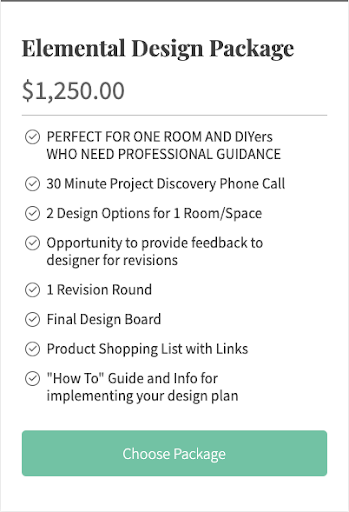Beautiful interior design is no longer reserved for the elite. The masses want stylish, well-thought-out spaces too. And therein lies the opportunity.
Middle-class families are the ideal clientele for many interior designers. To save money on the service, many clients prefer to pay only for the design and product recommendations. Then, they purchase the products and install items themselves.
Designers can focus on what they do best—design—without having to manage product orders, receiving, warehousing, and installation.
If you love the idea of running a design business but you’re looking for a simpler business model, e-design could be the perfect fit. Many e-designers earn between $125 to $250 per hour, making it a great work-from-home business.
In this guide, we show you how to start a profitable e-design business from scratch.
Table of Contents
What’s an e-design business?
An e-design business operates fully online. The interior designer communicates with clients to understand their needs and style preferences. Clients provide measurements of their space so the designer can create an accurate floor plan and moodboard with product selections that will fit perfectly and achieve the desired transformation.
Is it a good time to start an e-design business?
Absolutely! Now’s a great time to start an e-design business because there are so many affordable business tools on the market and much of your promotion methods can be 100% organic (meaning you don’t have to pay for ads).
In 2025, all you need to get started is a website, e-design software, and some free marketing methods, such as your Instagram account and your networking prowess.
Benefits and drawbacks of starting an e-design business
Because e-designers don’t provide warehousing and installation services, e-design businesses are less complex and easier to run than full-service design studios. And if you love to travel, an e-design business affords lifestyle freedom, as you can work with clients all over the world.
As for the cons, like any business, there will be downsides. Because many e-designers offer low pricing, it can feel like a race to the bottom. To mitigate this, it’s important to really create a unique style and a clear niche that calls in higher-paying clients.
9 steps to start an e-design business
You’re ready to use your creativity and earn a living doing what you love. Follow these steps to launch a thriving e-design business.
1. Choose your niche
The first step is to choose your niche. What do you love to design? What do you have experience with?
Try not to get too hung up on this choice. You can always change or tweak it later. And remember, a niche doesn’t mean that’s the only type of design you offer. It just means it makes up the majority of your projects and it’s what gets people in the door. You’ll attract more clients by having a specific niche than none at all.
Here are some different types of niches to get your wheels turning.
Styles:
- Mid-century modern
- Minimalist
- Scandinavian
- Industrial
- Mediterranean
Rooms:
- Living room
- Kitchen
- Nursery
- She shed
- Home office
Mood:
- Tranquil
- Feminine
- Whimsical
- Earthy
- Exotic
Types of clients:
- New moms
- Young families
- Young professionals
- Empty nesters
- Families with teenage kids
Check out our e-book on building an e-design business for more niche ideas.
2. Name your business and make it official
Now that you have a good feel for your niche, it’s time to name your business. Choose a name that speaks to your niche.
For instance, if you want to create peaceful and tranquil living rooms, you might go for a name like “Peace and Loveseat,” which is clear but also playful.
On the other hand, be careful with being too literal, in case you change your niche down the line. You might simply use your first or last name as your studio name.
Be sure to incorporate your business according to local laws. You might need a business lawyer to help. Many states and provinces don’t require that you have a license to operate a design business, but be sure to check.
3. Create a logo and website
The next step is to brand your business. You can hire a logo designer, or use a tool like TailorBrands or Canva to design your own. Create a color palette that matches your niche and style and utilize the main color for your logo.
Use a platform like WordPress, Wix, or Squarespace to easily create a website without having to hire a designer. Just use a template that matches your desired style to save time on customizations.
4. Use interior design software to streamline your business
After you’ve got your website set up, choose an interior design business management platform that gives you all the tools you need in one place: moodboard software, 3D floor planning, invoices, quotes, payment processing, client questionnaires, client feedback, and more.
With an all-in-one-style platform, you don’t have to cobble together dozens of different design and project management tools—making it so much easier to get your work done.
It’s a good idea to familiarize yourself with your design software and create a few designs before you have client projects. If you don’t have a portfolio yet, use these designs instead. Add them to your site and share them on social media.
Learn more about DesignFiles, the top-rated choice for solo and small design businesses.
5. Set up your initial packages
Next, create your design offers, such as one-room, two-room, and/or paint consultation packages. Remember, you can always add or remove packages later, but start by creating two or three unique offers that solve a specific problem for your target audience.
With DesignFiles, you can embed your packages on your website and take payments upfront. Here’s an example from Laurel Alexander Interiors.

Check out our guide to interior design pricing packages for more tips on crafting your offers and setting the prices.
6. Reach out to your personal network
With your website and packages launched, it’s a good idea to let everyone in your network know about your new business. Craft an email template that you can customize for different family members and friends.
Include details on why you started your business, what you offer, and who you serve. Let people know if you have any referral incentives, or just politely ask people to recommend you.
7. Create a marketing plan for the quarter
Hopefully, you’ll be able to get your first few clients from your personal network. You can then leverage these projects to build your portfolio and generate even more referrals.
It’s also a good idea to craft a simple quarterly marketing plan so you’re not solely reliant on referrals. Some of the best marketing methods for e-designers include social media, search engine optimization, publicity, and email marketing.
Choose just one or two strategies to begin with. Write a list of every task you need to accomplish and spread them out across the quarter.
Check out our guide on proven marketing methods for more tips and tutorials to help you craft your plan.
8. Track leads in a CRM
As you start to generate leads, it’s very important to keep track of them. You can use a CRM like Dubsado or Mailchimp, which will allow you to automatically keep in touch with your leads.
Or, simply add leads to a Kanban board in Trello or Asana. Create different columns, such as New Lead, Nurture Process, Won Client, Cold Lead, etc. Each day, you can head over to the board to see who you need to manually follow up with.
For many leads, the problem isn’t that they don’t want to work with you. It’s timing. Over time, you’ll build a library of cold leads who couldn’t move forward for whatever reason. You can follow up with them every six months or so.
9. Learn digital and traditional sales techniques
As an e-designer, you’ll have a variety of sales methods at your disposal. You can offer free 20-minute consultations where you explain your process and help clients choose the right package.
You can also sell your services through Instagram, Facebook, and LinkedIn messaging. When clients reach out to you on these platforms, respond to their questions and then ask a question of your own to keep the conversation flowing.
Great salespeople aren’t trying to force someone to buy something. Instead, they ask questions to get the details they need to be of service—even if that means recommending another business owner. This service-oriented approach will make clients more likely to work with you and recommend you to others.
Be sure to check out our guide to interior design sales for tons of time-tested sales tips from designer Monique Holmes.
Key resources & tools for your e-design business
Here are some essential resources and tools to help you start and grow your business.
- [E-book] Building a Successful E-Design Business – Check our e-book on how to build a thriving e-design business, including tips on pricing and marketing—as well as a detailed list of different niches to choose from.
- [E-book] Interior Design Websites That Sell – Building a website for the first time? This e-book makes it easy. Discover what makes for a great e-design business website, and use our templates for key pages like service pages, about pages, contact forms, and more.
- [Virtual Conference] E-Design Business Building Week – This YouTube playlist contains all of the replays for our virtual conference, E-Design Business Building Week. Learn from successful e-designers about how to set accurate pricing and grow your clientele.
- [Software] E-design business management software – DesignFiles offers the moodboard tools, 3D floor planner, and client communication tools you need.
- [Book] Profit First by Mike Michalowicz – Profit First is one of the most famous books for small business owners. It teaches you how to set up multiple business bank accounts so you can accurately manage your money, save your revenue in good months, and protect your money during the slow months.
How to streamline your e-design business
To streamline your e-design business, be sure to use software that includes all of the client and project management tools you need in one place. If you use a variety of different design platforms, invoicing software, and client communication tools, details on each project will be spread across the web.
Choose an all-in-one platform that offers moodboard software, a floor planning tool, 3D renderings, customizable design questionnaires for clients, design feedback, client activity log, quotes, invoices, task management, and time tracking. By consolidating your workflow, you’ll save hours on each project.
How to promote your e-design business
When it comes time to market your e-design business, there are a variety of methods you can use. Here are some of the most effective marketing strategies for e-designers.
Traditional marketing methods:
- Networking
- Referral partnerships and swaps (other business owners)
- Referral incentives (clients)
- Sponsoring local organizations
- Local publicity (newspapers or lifestyle magazines)
Digital marketing methods:
- Personal Facebook profiles
- Facebook business pages
- Facebook ads
- Google ads
- Search engine optimization
Frequently asked questions
An e-design business operates 100% virtually. E-designers can serve both residential and commercial clients by providing design boards, floor plans, and 3D renders. Unlike full-service designers, e-designers typically don’t manage the installation process. Clients purchase recommended products and install everything themselves according to the approved design.
To start an e-design business, you’ll need a clear understanding of your niche and unique style. It’s easier to build a profitable business when you stand out from the competition. For instance, you might specialize in nursery design, urban lofts, or coastal AirBnbs. Once you’ve got your niche, use your website and social media to call in your ideal client. And be sure to use e-design software to help you run and grow your business.
To market your e-design business, use a combination of traditional and digital marketing methods. Some of the most effective traditional marketing tactics include referral partnerships, networking, and local publicity. As for digital marketing, social media and SEO reign supreme.
An e-design business is one of the most affordable online businesses to start. Initially, a budget of $1000 should be more than enough. Use this to pay for any necessary business licenses, incorporation fees, and website development. You can save money by designing your website yourself with an easy-to-use platform like Wix or Squarespace. You’ll also need to invest in an e-design platform like DesignFiles, which can be paid for on a monthly basis.
Start and grow your e-design business with DesignFiles, the top-rated platform for solo and small design studios. Learn more about DesignFiles.


